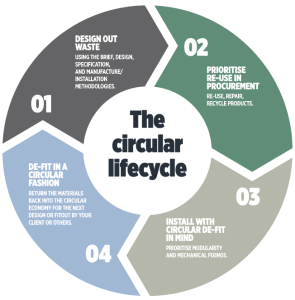In a world increasingly focused on sustainability, the construction and interior fitout industry is poised to undergo a transformative shift towards a circular economy.
This new paradigm – the likely future of commercial interior design – is championed by leaders like Vanessa Cullen, CEO of Forward Thinking Design, who heralds a departure from traditional linear practices to embrace a more thoughtful and enduring approach.
From Concept to Construction
“The circular economy is a new way of thinking that views materials as enduring resources, not consumables that are used up and then sent to waste,” Vanessa says simply.
It’s an approach which challenges the status quo, emphasising the importance of preserving the value of materials throughout their lifecycle – often outlasting a traditional five to seven-year fitout.
For builders and shopfitters, the circular economy lifecycle involves a comprehensive strategy, starting with ‘designing out waste.’
This entails considering every phase – from the initial brief and design, to the specification, manufacture and installation.
“The goal is to minimise waste generation from the very inception of a project.
“Prioritising re-use in procurement is another crucial aspect,” Vanessa points out.
“This involves seeking out materials that can be re-used, repaired or recycled, and even exploring product-as-a-service models.”
The concept is not new, but it has gained popularity over the past decade.
Australia’s Federal and State governments are increasingly pushing a circular economy in the waste sector to create domestic manufacturing and recycling connections within international markets.
However, according to the CSIRO, Australia’s circularity rate is recorded at just 5.4 percent.
Vanessa believes the next major step will be within commercial design, and choosing items with circularity in mind will lead to businesses and builders contributing significantly to the longevity and sustainability of projects.
Retail giants like Officeworks are already adopting the idea – partnering with Queensland-based organisation Circonomy to open Victoria’s first circular economy recovery and repair service last year to collect, repair, repurpose and resell damaged or customer-returned products.
The initiative feeds into Officeworks’ plan to become a zero-waste business.
Circonomy Founder Yas Grigaliunas said the organisation also recently collaborated with national development and management property group Mirvac.
“We embarked on an ambitious project in Melbourne together, aiming to remove items and materials from 12 floors of office space with the goal of diverting 100 percent of these materials from landfill,” Yas explains.
“It not only transformed office spaces but unlocked new social procurement opportunities and made a positive social and environmental impact.
“We were effectively able to offer an end-to-end solution to maximise the value of the resources removed during the strip-out process.”
It led to repurposing 3,000 pieces of loose furniture, the removal, cleaning and repackaging of 792 large commercial blinds, 7,920 ceiling tiles removed and reused, and protecting the existing carpet tiles for reuse in the new fitout.
The installation phase plays a pivotal role in the circular economy, according to Vanessa.
“We encourage adopting practices that facilitate circular de-fit, which often requires thought around modularity and mechanical fixings.
“This ensures that after a five or seven-year lease for example, the disassembly and removal processes is efficient and allows for the salvage of materials for future use.”
Rethinking waste and recycling
While many practice recycling, there is a critical distinction between recycling and being ‘circular’.
“Recycling – while beneficial – inherently downgrades the value of materials due to the loss of initial extraction, manufacturing, design, and labour investments,” Vanessa points out.
“The circular economy, on the other hand, prioritises adaptive re-use and repair to maximise the value of materials before considering remanufacture or recycling.”
“So, instead of sending an object or material that has 10 plus years of useful life to recycling, circularity presents the creative sustainability challenge of considering other use possibilities.”
This challenges our industry of shop and office fitters, specialist contractors and service providers, designers and developers to think beyond the conventional endpoint and explore innovative ways to extend the lifespan of materials, unlocking their full potential.
“In essence, the circular economy in construction and fitout is about creating a sustainable ecosystem where materials continually circulate, adding value at each stage.”
It’s a shift that not only aligns with environmental goals but also presents an opportunity to lead the way in sustainable practices, fostering a legacy of responsible construction for generations to come.


